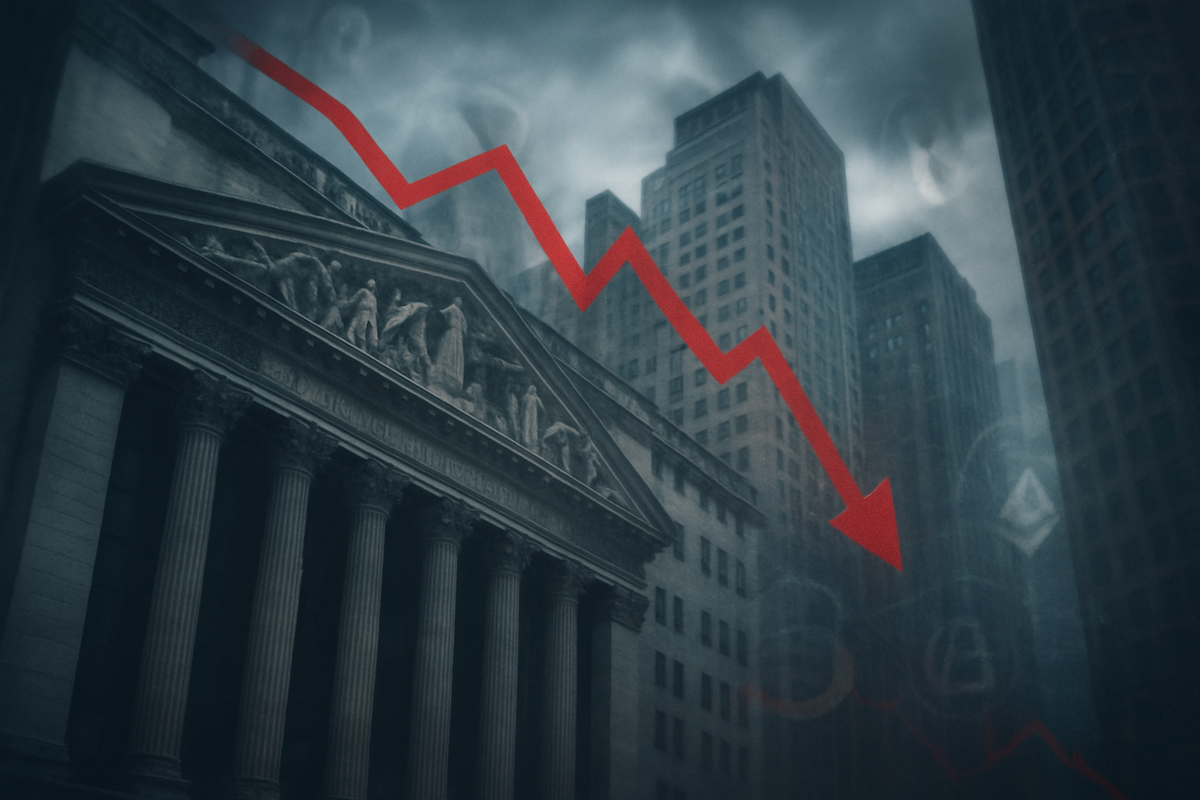
Wall Street finds itself in a precarious position as November 2025 unfolds, marked by a palpable shift from cautious optimism to growing unease. After a robust October saw major indices post solid gains, the market has begun to "slip again," signaling a broader decline fueled by a confluence of factors. This downturn is not merely a minor correction but reflects deep-seated concerns over stretched valuations in the technology sector, a slowing U.S. economy, and significant volatility within the cryptocurrency market. The immediate implication for investors is a period of heightened uncertainty, demanding a re-evaluation of portfolios and a keen eye on macroeconomic indicators, as the broader economy grapples with slowing job growth, persistent inflation, and disrupted global trade.
The prevailing market sentiment is a complex tapestry woven with threads of both lingering bullishness and increasing apprehension. While risk appetite among US equity investors reportedly improved earlier in the month, reaching its highest level this year, this optimism is being overshadowed by a decline in consumer sentiment and creeping volatility. The Federal Reserve's (FED) interest rate policy remains a critical point of contention, with initial hopes for further cuts now giving way to doubts, adding another layer of complexity to an already fragile market. As the market navigates these turbulent waters, the performance of bellwether tech companies and the unpredictable nature of digital assets are proving to be significant determinants of Wall Street's immediate trajectory.
A Turbulent November: Unpacking Wall Street's Retreat
The current market retreat on Wall Street in November 2025 represents a significant shift from the preceding month's performance. October concluded with impressive gains, as the S&P 500 climbed 2.3%, the Nasdaq (NDAQ) surged 4.7%, and the Dow Jones Industrial Average (DJIA) advanced 2.5%, extending a six-month winning streak. This momentum was largely attributed to a wave of optimism surrounding artificial intelligence (AI) advancements, strong corporate earnings reports from the third quarter, and a perceived easing of global trade tensions. The U.S. economy was projected to expand at a respectable 1.8% year-over-year for 2025, contributing to a generally positive outlook.
However, the tide began to turn as November commenced. Reports quickly emerged of the U.S. stock market "slipping again," with major indices experiencing sharp, unpredictable swings. A notable "risk-off session" was observed towards the end of a recent week, indicating a collective move by investors away from riskier assets. This shift was primarily driven by renewed concerns over the high valuations prevalent within the technology sector, which many analysts now view as unsustainable. Adding to the unease was persistent uncertainty regarding the Federal Reserve's (FED) future interest rate policy, with conflicting signals about potential rate cuts or even hikes. Economic data further fueled the apprehension, with U.S. GDP growth reportedly slowing in the second half of 2025, which in turn weakened consumer sentiment. Warnings of rising commercial real estate delinquencies and potential widespread job losses also began to circulate, painting a picture of potential economic fragility.
Key players in this unfolding scenario include the Federal Reserve, whose monetary policy decisions continue to exert immense influence over market direction. Major technology companies, particularly those with high growth expectations and valuations tied to AI, are also central figures, as their performance significantly impacts overall market sentiment. Investors, from institutional funds to individual retail traders, are the primary stakeholders, directly experiencing the effects of this volatility. Initial market reactions have been characterized by increased selling pressure, particularly in overvalued sectors, and a general move towards safer assets, reflecting a growing sense of caution and a retreat from the aggressive risk-taking seen in previous months. The LSEG/Ipsos Primary Consumer Sentiment Index declined by 1.5 points in November, further underscoring the deteriorating confidence among the public.
Navigating the Downturn: Winners and Losers in a Volatile Market
The current market decline and heightened volatility are creating a distinct bifurcation among public companies, with some poised to suffer significant setbacks while others may find unexpected opportunities. Major tech companies, which have largely driven market gains over the past year, are now facing intense scrutiny and are among the most vulnerable. Companies like Nvidia (NVDA), a bellwether for the AI boom, have already seen their shares "slipping again" in November, with an 8.6% decline ahead of its earnings report raising concerns about overvaluation. Other tech giants such as Microsoft (MSFT) and Amazon (AMZN) have also experienced declines in early November. These companies, characterized by high growth expectations and often lofty valuations, are susceptible to investor pullbacks when market sentiment sours and concerns about future earnings growth or interest rate impacts intensify. A sustained market downturn could lead to reduced consumer and business spending on technology, impacting their revenue streams and profitability.
The cryptocurrency market's severe volatility is also directly impacting companies with significant exposure to digital assets. Publicly traded companies that hold substantial amounts of Bitcoin (BTC) or Ethereum (ETH) on their balance sheets, or those heavily invested in crypto mining operations and blockchain technology development, are likely to see their valuations pressured. A 25% decline in Bitcoin from its October high of $126,200 to $89,100 in November, coupled with Ethereum falling below $3,000, directly affects the asset value of these companies. While specific examples of listed companies heavily exposed to crypto aren't detailed in the research, any firm with significant crypto holdings or business models reliant on a booming crypto market would be considered a "loser" in this scenario.
Conversely, certain sectors and companies may emerge as relative "winners" or at least demonstrate resilience during this period of market contraction. Defensive stocks, typically found in consumer staples (e.g., Procter & Gamble - PG, Walmart - WMT), utilities, and healthcare (e.g., Johnson & Johnson - JNJ), tend to perform better in downturns as their demand remains relatively inelastic regardless of economic conditions. Companies with strong balance sheets, consistent dividend payouts, and less sensitivity to economic cycles are often favored by investors seeking stability. Furthermore, companies that benefit from a "risk-off" environment, such as those in the gold or precious metals industry, or those offering essential services with stable cash flows, could see increased investor interest. While the research doesn't explicitly name "winners," the general principles of market downturns suggest a flight to quality and stability, benefiting companies with robust fundamentals and less speculative business models.
Broader Implications: A Shifting Economic Landscape
The current Wall Street decline is not an isolated event but rather a significant symptom of broader shifts occurring within the global economic landscape. This downturn fits squarely into a trend of increasing market fragility and uncertainty that has been building throughout 2025. Broader industry trends include a re-evaluation of growth stocks, particularly in tech, where the exuberance of the AI boom is being tempered by concerns about sustainable profitability and market saturation. There's also a growing recognition of the impact of geopolitical tensions on global trade and supply chains, leading to a more localized and diversified approach to production and sourcing. The slowing U.S. GDP growth and weakening consumer sentiment are indicative of a broader economic deceleration that could affect multiple sectors, from retail to manufacturing.
The ripple effects of this market correction are likely to be far-reaching, impacting competitors, partners, and the overall business ecosystem. For competitors, a downturn can intensify competition for market share, especially if consumer spending tightens. Companies with weaker balance sheets or less diversified revenue streams may struggle to compete against more resilient rivals. Partners, particularly those in supply chains or joint ventures, could face disruptions if key players scale back operations or face financial difficulties. For instance, layoffs announced by major companies like Amazon (AMZN) and UPS (UPS) signal a broader trend of cost-cutting that will affect numerous smaller businesses reliant on these giants. The global economy is already described as "limping" amidst geopolitical crosswinds, policy fragmentation, and structural shifts, making any significant market tremor reverberate widely.
Regulatory and policy implications are also coming to the forefront. The Federal Reserve's (FED) interest rate decisions remain paramount, with every statement and action scrutinized for its potential impact on inflation and economic growth. If the market decline persists or deepens, there could be increased pressure on policymakers to intervene with fiscal stimuli or more accommodative monetary policies, though the current inflationary environment complicates such measures. Furthermore, the rising commercial real estate delinquencies could trigger regulatory responses aimed at stabilizing the financial sector. Historically, market corrections of this magnitude often lead to calls for stricter oversight of financial markets, particularly in areas perceived as speculative, such as cryptocurrency. Comparing this event to historical precedents, such as the dot-com bubble burst or the 2008 financial crisis, reveals similarities in the overvaluation of certain sectors and the role of speculative assets, though the specific triggers and global economic context are unique to the current period.
What Comes Next: Navigating the Crossroads
Looking ahead, Wall Street faces a period of significant strategic recalibration, with both short-term challenges and long-term opportunities emerging from the current decline. In the short term, the market is likely to remain highly volatile, influenced by incoming economic data, corporate earnings reports, and the Federal Reserve's (FED) ongoing deliberations on interest rates. Investors should anticipate continued price swings and potentially further corrections, particularly in sectors that remain overvalued. The immediate focus for many companies will be on shoring up balance sheets, optimizing operational efficiencies, and carefully managing cash flow in a tighter economic environment. For consumers, the slowing job growth and declining sentiment could lead to more conservative spending habits, impacting retail and discretionary sectors.
Long-term possibilities suggest a market that eventually finds a new equilibrium, albeit potentially at lower valuations for some assets. The underlying strength in certain areas, such as the continued innovation in AI and select growth sectors, could still drive future gains once the current volatility subsides. However, companies will need to adapt strategically. This may involve pivoting towards more resilient business models, diversifying revenue streams away from overly reliant sectors, and focusing on sustainable growth rather than speculative expansion. For instance, tech companies might need to demonstrate clearer paths to profitability rather than just user growth, and those in the crypto space may need to focus on real-world utility and regulatory compliance.
Market opportunities will undoubtedly emerge for astute investors. A downturn often presents opportunities to acquire high-quality assets at discounted prices. Undervalued growth stocks, companies with strong competitive moats, and those in defensive sectors could become attractive. Furthermore, the focus on supply chain resilience and domestic production could create opportunities for manufacturing and logistics companies. Challenges will include navigating persistent inflation, potential interest rate hikes, and the ongoing geopolitical instability that impacts global trade. Potential scenarios range from a gradual recovery in the latter half of 2026, assuming economic conditions stabilize and inflation is brought under control, to a more prolonged period of stagnation if economic headwinds intensify and corporate earnings disappoint. The outcome will largely depend on the Federal Reserve's (FED) policy effectiveness, the resilience of corporate America, and the resolution of global trade tensions.
A Comprehensive Wrap-Up: Navigating the New Market Reality
The current decline on Wall Street in November 2025 represents a critical juncture for financial markets, signaling a clear shift from the sustained bullishness of previous periods. Key takeaways from this event underscore the fragility of markets when valuations become stretched, particularly in high-growth sectors like technology, and when macroeconomic indicators begin to flash warning signs. The intertwined roles of major tech companies, whose strong performance often masks broader weaknesses, and the highly volatile cryptocurrency market, acting as both a speculative magnet and a source of systemic risk, have been central to this downturn. The immediate implications include increased market volatility, a tightening of financial conditions, and a re-evaluation of risk across all asset classes.
Moving forward, the market is likely to remain in a state of flux, characterized by continued uncertainty. The era of easy money and seemingly endless growth for all tech companies appears to be waning, replaced by a more discerning environment where fundamental strength, profitability, and sustainable business models will be paramount. Investors should anticipate a period of consolidation, where companies with robust balance sheets and clear value propositions will likely outperform those built on speculative growth. The ongoing battle against inflation, coupled with the Federal Reserve's (FED) cautious approach to monetary policy, will continue to be a dominant theme, dictating the pace of any potential recovery.
The lasting impact of this event could be a more disciplined and realistic approach to investing, moving away from the "fear of missing out" (FOMO) mentality that often drives speculative bubbles. It serves as a stark reminder that market cycles are inevitable and that periods of correction are a natural, albeit painful, part of the economic rhythm. What investors should watch for in the coming months includes further clarity on the Federal Reserve's (FED) interest rate path, signs of stabilization or further deterioration in key economic indicators such as GDP growth and employment figures, and the resilience of corporate earnings, particularly from the tech sector. Monitoring global trade developments and geopolitical events will also be crucial, as these external factors can significantly influence market sentiment and economic stability.
This content is intended for informational purposes only and is not financial advice







